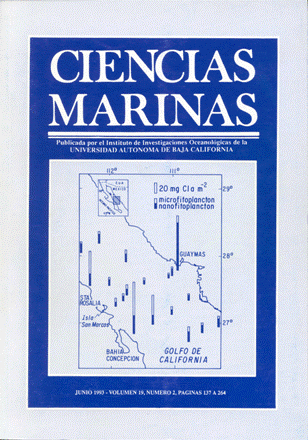Seasonal changes of brown shrimp (Penaeus aztecus) abundance in the northwestern Gulf of Mexico related to environmental factors
Main Article Content
Abstract
An analysis was made of the seasonal changes of abundance of the brown shrimp (Penaeus azfecus) population in the northwestern Gulf of Mexico, related to environmental parameters such as rainfall and fishing effort. Using monthly age-class abundance data (given as catch per unit effort) for the period 1974 to 1982, a principal components analysis was applied and two population indexes were obtained: recruitment strength (as a monthly class strength) and adult density (Solana-Sansores et al., 1989) which is inversely proportional to the log of their actual abundance. Both indexes and the records of environmental parameters were analysed using the multivariate method of canonical correlation. The first canonical correlation was highly significant (P < 0.01) and includes mainly fishing effort and the recruitment strength index. The second one showed a high correlation between rainfall and the adult index. The results show how some environmental factors help to explain the fluctuations observed in the general behaviour pattern of the population. This suggests the convenience of incorporating these factors (rainfall and fishing effort)-in fisheries models.
Downloads
Article Details
This is an open access article distributed under a Creative Commons Attribution 4.0 License, which allows you to share and adapt the work, as long as you give appropriate credit to the original author(s) and the source, provide a link to the Creative Commons license, and indicate if changes were made. Figures, tables and other elements in the article are included in the article’s CC BY 4.0 license, unless otherwise indicated. The journal title is protected by copyrights and not subject to this license. Full license deed can be viewed here.

